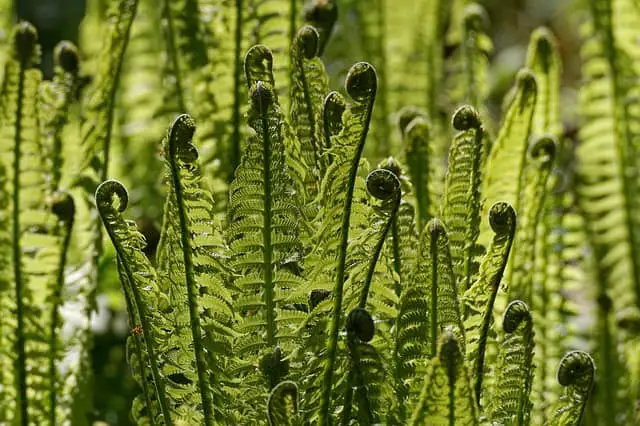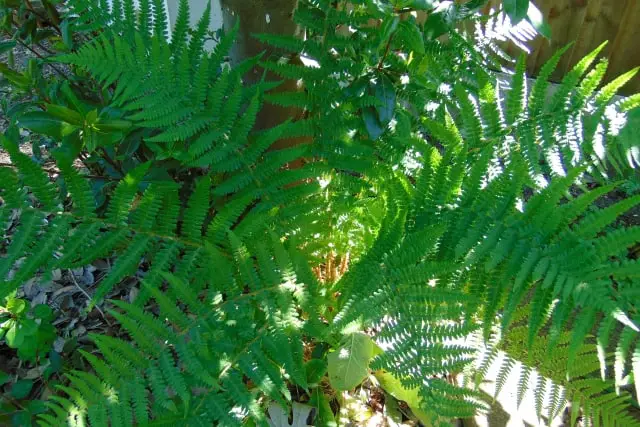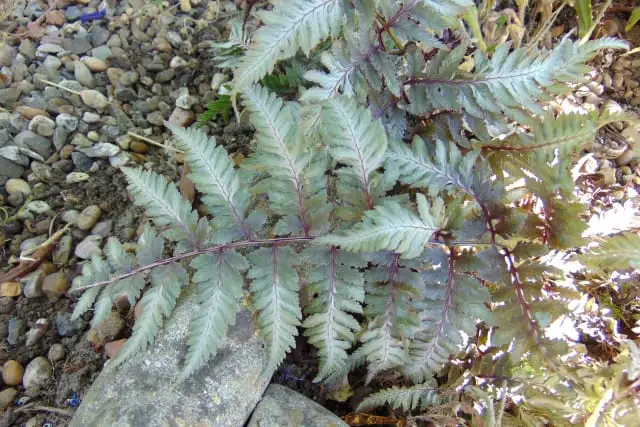When choosing a fern from a garden center or nursery, a key concern is how long it will take for it to grow to full size. How big a specimen do you need to buy? How fast do ferns grow once planted or potted? Will you need to feed them to coax more growth, or prune them hard to keep them under control?
Ferns can grow new fronds rapidly throughout the growing season, forming a crown within a few weeks. Individual fiddleheads (each newly emerging frond) can unfurl and expand within days. But, it typically takes five to ten years for a fern to reach full maturity after planting, when the full height and spread of the plant will be achieved. Tree ferns are the slowest growing ferns, and can continue to gain height for decades.
Really, there are two ways to think about the rate at which ferns grow: how fast they put on new foliage each year during the growing season, and how long it takes for an individual plant to reach maturity – when the full bushy spread has reached its likely limit.

As you would expect, there is plenty of variation between different fern species, but also some useful rules of thumb that apply for most of the common varieties used in the house and garden.
The fastest growing ferns
Ferns are perennial plants, but many varieties are deciduous and will lose their fronds in fall and winter. This helps illustrate how rapid the growth of ferns can be, as each spring the whole plant is regenerated from new growth. For evergreen varieties that do not lose their fronds, they nevertheless follow a growing season and will send up new fronds each year, even if the older fronds are still intact.
New fronds emerge in the form of fiddleheads (or, more formally, “croziers”) that grow from the rhizome at the base of the plant and rapidly rise up from the soil, unfurling as they go, to form the new fan-like frond. This process can be very fast. Here is a great time lapse video of fiddleheads growing from first appearance to fully open frond in less than a week:
Ostrich ferns are among the fastest growing of the common garden varieties. These plants can form huge bushes of broad, feathery fronds that stand up to a meter and a half (five feet) tall within weeks.

Ostrich fern
- Matteuccia struthiopteris
- Deciduous
- Full or partial shade
- Height: up to 1.5 m
- Soil: acid or neutral. Moist, well-drained.
Most other popular ferns follow a similar time scale, but grow to less impressive heights. For evergreen varieties, this will not be so obvious, as new growth will be lost amongst existing foliage, and will be limited if the plant already has a good crop of healthy green fronds. However, pruning back old fronds before spring will reveal this growth potential as it stimulates the emergence of vibrant new fiddleheads to recover the lost crown.
The record holder for fastest growing fern is probably the aquatic Water Sprite or Indian water fern (Ceratopteris thalictroides). This variety is unusual, not just because it grows submerged in water, but because it seems to follow an annual growth pattern, despite being able to succeed as a perennial (certainly within an aquarium, for example). But in the wild, the Water Sprite grows fresh each new year from spores, putting on explosive growth over a short period.
How long to reach full height and spread?
Annual growth is only one aspect of how long it will take for a fern to grow to maturity. When it comes to matching a plant to a plot, it is as important to understand what the final height and spread of the fern will be once it is fully established.
Most ferns follow a similar timescale for development. It typically takes five to ten years for an individual plant to reach maturity, at which point the annual cycle of growth will result in a similar size and shape of crown emerging each year. This is true for both robust, sculptural ferns like the Male fern, and the more decorative, delicate varieties like the Japanese painted fern.

Male fern
- Dryopteris filix-mas
- Deciduous
- Prefers partial or full shade
- Height: up to 1.5 m
- Soil: acid, neutral or alkaline. Moist, poor drainage tolerated.

Japanese painted fern
- Athyrium niponicum
- Deciduous
- Prefers partial shade
- Height: up to 0.5 m
- Soil: acid, neutral or alkaline. Moist, well-drained.
That should help with planning for which fern to buy – if you buy a younger specimen that has not yet reached its full potential, it is likely to take a few years to reach its ultimate height and spread. Check the label on the fern, or refer to our list of ferns to find out what the future has in store.
A last thought on this topic is that crown-forming ferns are generally predictable and well behaved, but creeping rhizome ferns are more difficult to accommodate, as they tend to spread through borders forming new crowns as they go, increasing both their ultimate range and the time taken to fill the available space.
Speeding up fern growth
If you want to hasten the growth of a fern, the only real option is to make sure you have matched the fern to the environment carefully.
Ferns can be sensitive to sunlight and drying out, and so getting these factors right is the best way to promote quick and healthy growth. Ideally, prepare the soil or potting mix to match the fern’s needs (most varieties prefer neutral or slightly acid soil), supplement with a good amount of organic matter such as leaf mold and drainage material such as grit, and choose a variety that is well matched to the daily sun levels through the year.
Ferns do not need fertilizer, and can’t really be “forced” by feeding. In fact, fertilizing too much is likely to slow growth by damaging the roots. That said, mulching in the fall or winter is fine, and helps keep the roots protected from frost while also providing slow-release nutrients in the spring.
The slowest growing ferns
Finally, it is worth a note on the slowest growing varieties of fern: the tree ferns. These amazing plants will take much longer to reach a mature height, because they just keep going.

The two main varieties, Dicksonia antarctica and Cyathea australis grow only a few centimeters each year, requiring considerable patience and a long life to see them reach their full potential. A variety known as Cooper’s tree fern (Cyathea cooperi) is the fastest growing tree fern species, taking a mere 20-50 years to reach a mature height of around five meters.
If you are interested in buying a tree fern, it is likely to require a considerable outlay, in either cost or time, to be able to enjoy the spectacle of its ancient trunk rising from amongst the plants below it.
Each year, ferns put on an impressively fast burst of new growth, which is beautiful to see as the emerging fiddleheads unfurl over a few days. In contrast, it can take many years for each individual fern to mature and reach its full potential.

